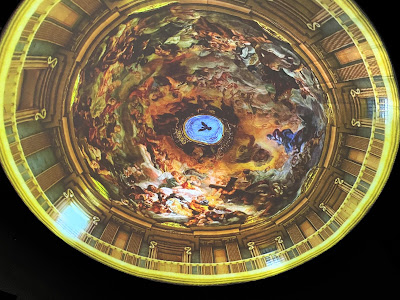I was skeptical about visiting a museum devoted to Baroque. When one thinks of Baroque, you think of gaudy and overly ornamental. But not only is the exterior of the International Museum of the Baroque sensational, the exhibition halls are just spectacular!
For over a century and a half, Baroque dominated all artistic disciplines: architecture, furniture, paintings, sculptures, music, literature... Think of Rubens, Rembrandt, "Don Quixote", Shakespeare... Baroque was found on four continents and it certainly left its mark on Puebla.
The height of Baroque during the 17th and 18th centuries was a prolific
time for art in Mexico. Baroque architecture is a highly opulent style of building,
design, and art that originated in Italy during the 17th century and
spread through out Europe, and eventually, to the new world. It's
characterized by extremely detailed forms, marble, large-scale
decoration, and bright colors.
Upon entering the museum, there is this massive reproduction of the sculpture of Friedrich Wilhelm, Elector of Brandenburg & Duke of Prussia (1620 - 1688). Designed in 1698 by Andreas Schluter who worked in Warsaw, Berlin and St. Petersburg. This famous equestrian statue was hidden during World Was II in Lake Tegel, Berlin. Restored in 1952, the original is on display at the Charlottenburg Palace in Berlin.
The permanent exhibition includes eight exhibition halls, each with a different theme that provides a broad view of the various appearances of the Baroque.
San Miguel Archangel - 18th Century - Puebla, Mexico
I am partial to San Miguel Archangel, the patron saint of San Miguel de Allende. That is the town where my passion for Mexico and its culture began, over 47 years ago!
The most impressive part of the museum is the large room that houses an enormous site plan of the historic center of Puebla along with 36 multimedia digital displays on each of the two walls. One can touch a button that will light up the location of this or that Baroque structure, including the intricately tiled Casa de Alfeñique and the Church of Santo Domingo.
One set of images fad out and the screens presents a new scene.
The Museo de Estado/Casa Alfenique, the state museum, with its intricate Baroque facade. Alfenique meaning "sugar paste".
The angel/cherub face being a typical motif in the Baroque carvings. In Cholula, outside of Puebla, is the magnificent Church of Santa María Tonantzintla featuring cherubs with distinctly indigenous features, carved into every last inch of the church’s stucco interior.
The towers of the main cathedral in Puebla. Construction of the cathedral began in 1575 and completed in 1648. There are bells only in one tower with one bell weighing 8.5 tons, the towers standing 240 feet high, the tallest in Mexico. It was feared that if a second bell was added, it would cause the Cathedral to sink into the ground. Legend has it that angels descended from heaven to place a particularly heavy bell in one of the towers of the cathedral, and that there is an underground river that flows under one of the towers.The progression of a church over the years as the Baroque style enhanced and facade and interiors of many churches.This style leaves no surface blank or untouched except for the sides which seems to frame the whole chaotic scene of saints, cherubs, flowers and vines among the various saints in their individual niches.
Seen on many churches and one of my favorites in San Miguel de Allende, the Templo de San Francisco church, is an architectural element, the Estipite, column which is the very hallmark of the Churrigueresque Baroque style. The stone columns narrow at the bottom instead of flaring out. Some say this was based on the human figure.
Each gallery has exceptional displays of text explaining the Baroque from the architecture, paintings, music, literature....
Drama, exaggerated emotion, theatricality and sensuality were key elements of the Baroque style.
This gallery shows the interest that upper-class Europeans developed in the “exotic” cultures they were increasingly hearing about from merchants and explorers. They started collecting artifacts and animal specimens to display in their lavish homes. Above is a re-creation of such a "collection" room, with shelving showcasing wonders from around the world, taxidermied birds and an alligator (on the ceiling), animal tusks and furniture from faraway lands.
For a break from the overwhelming world of the Baroque, step out into the central courtyard,
sit on one of the curved wall-benches, soak up the sun and enjoy the tranquility of the setting and the sound of the water as it makes it way to the center, creating a gentle but mesmerizing whirlpool.
I barely scratched the surface on what is on display within these walls. The International Museum of the Baroque is truly one of the best museums around. Not that I am in love with everything Baroque, but the exhibitions are so well executed and thought out. Each gallery draws one into the next. The visual multimedia digital displays are beyond words. I could have sat there and watched each segment over and over again. And finally, the architecture is just so beautiful from the exterior facade to the interior courtyard. The flowing walls create such tranquility but majestic grandeur at the same time.
When visiting Puebla, this museum is a must! I just recently returned from Puebla, Veracruz and San Miguel de Allende and another visit to this museum was definitely well worth it. It is about a 15 minute taxi ride from the historic center of Puebla. Plan on two hours minimum. The museum opens at 10:00 and on Sunday it is free admission.
FYI - For more on the museum, visit my post dated January 13, when I wrote about the magnificent facade showcasing many of my photos.




















No comments:
Post a Comment